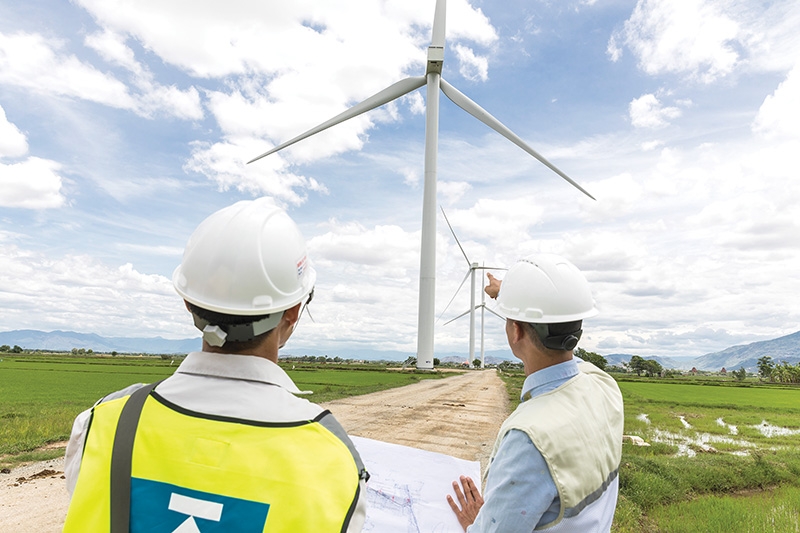Methods to achieve growth in tandem with energy goals
 |
| Henri Wasnick - Senior advisor of Renewable Energy Center, Institute of Energy |
To that end, wind energy is considered the most clean and feasible candidate, with an emission rate of about less than 10g CO2 per kWh.
A combination of onshore and offshore wind energy can technically produce a necessary amount, potentially feeding the country’s growing electricity demand of about 10 per cent a year. The positive socioeconomic, security, ecology, and environmental impact that might follow can actively contribute to the realisation of the goals in the Politburo’s Resolution No.55-NQ/TW dated February 2020 on the orientation of the National Energy Development Strategy of Vietnam towards 2030, with a vision to 2045.
At present, most offshore projects are concentrated in the south-central provinces of Binh Thuan, Ninh Thuan, and Khanh Hoa, where wind speeds stay at approximately over 7-9m per second and the technical potential is estimated at about 80GW. With highly consistent and higher wind speeds (thus bigger yield generation per a specific surface), a decreasing generation cost (by about 32 per cent) worldwide, and an ability to create new jobs, this energy is linked to lower electricity production cost and promising changes in socioeconomic conditions.
During the last two years, much effort has been put into leveraging the resource. Serious international investors and developers of projects over 15GW carried out a lot of preliminary work such as preparation of research proposals, geographic mapping, potential site identification, and preparation of grid-connection concepts. An offshore roadmap was also drawn up with supplementary input from consultations with the sector representatives to assist Vietnam with their technical expertise.
In terms of transmission network development, the government as well as Electricity of Vietnam (EVN) are showing their strong commitment and support. However, there remain some key challenges to be tackled, including but not only limited to institutional uncertainties such as missing regulations, requests for support policies, regulated decision-making processes, and tariff development.
Clear regulations
In order to pursue the goal of economic growth as low in CO2 emissions as possible and to implement it in line with the goals of Resolution 55, a clear position from the government and objective for offshore wind capacity is important. Long-term and upmost regulations and policies shall include but not only limited to electricity procurement policy, planning in the areas of marine spatial planning, technical requirements, approval processes, design of a bankable power purchase agreement (PPA), supply chains regulations, port development plan, and possibly a vision for a local content strategy.
The planning for infrastructure development is equivalently important, with regard to transmission network capacities. For the regulatory framework, it is recommended to consult international standards, especially concerning environmental impact, social impact, and health and safety as well as other norms.
As of today, 24 wind projects onshore and nearshore are registered to be in operation with 755MW. Up to 7GW have been approved for inclusion in the National Power Development Plan (PDP7 rev). A specific situation as wind energy onshore and nearshore currently has a specific momentum, as many projects are between an application process for the PDP7 revised version and on the other hand it is clear that the PDP8 is to be expected soon. Another 6GW have been registered for approval. It is envisaged that these projects will have reached a commercial operation date (COD) by 2025 but not all of these projects are likely to be implemented. In fact, a certain number of approved projects have difficulties to find an investor and to reach COD due to low project quality, which can be contributed by various reasons – for example, low wind speed, far away connection points or high risk of curtailment, uncertainties with land use rights, and high merger prices. Anyhow, these “poor quality projects” are included in the PDP while they are blocking the targeted installed capacity. The fact was foreseen for bankable and feasible projects.
The current wind energy feed-in tariff (FiT), which will end with the latest COD in October 2021, has attracted various interests and market participants. Since the end of 2020, the first draft for the third FiT for wind onshore and nearshore was in discussion. However, for most of the market participants it is not surprising that a lower FiT price shall be considered. It is important to understand that the FiT mechanism has various factors that drive project realisation. Against this reality, in fact the lower FiT, after a certain number of installed capacities, could help to steer initial project planning to high quality areas with a minimum of necessary wind speed, good possibilities for grid connection, and for land use rights. This, together with a scoring mechanism in the form of a project development rating, which makes good projects with process to an “early mover”, can support more feasible projects in the energy mix to probably find an investor and reach COD.
The FiT level is, however, not the only decisive factor for project due diligence or for project in operation. It is only one single piece in a big picture of many factors bringing to project realisation. Bankable PPAs, project due diligence, clear administrative procedures, and political landscape are also taken into account while investments are made.
However, it is unclear whether there should continue to be a FiT. Several scenarios are conceivable. To keep the FiT mechanism for high quality projects that are well advanced and to reduce it in a meaningful way. A second conceivable scenario is that at the end of October a high scale effect of installed capacity may lead to the FiT being exchanged through a competitive bidding auctioning with investor selection, probably similar to the current solar draft. Most developers work with both scenarios in their preview.
 |
| Wind energy is linked to lower electricity production and stronger future socioeconomic conditions, Photo: GIZ |
Expiring too soon
It must also be considered that the current implementation cycles, which are being discussed, are still far too short for many large-scale projects within the same time frame. Problems in the supply chain shall be born, for example, shortage of cranes and experienced transport services and there will be drastic bottlenecks.
After successfully submitting an investment license, along with securing the property, network connection contract, financial closing, and down payment of the wind turbine, investors can only see the equipment arrive at a port in Vietnam in around 9-15 months.
In addition, transportation from port to the project site and construction takes time, and commissioning phases in Vietnam experience the same problem. Realistically, onshore wind projects will need at least two years to move from the investment license stage to the commercial date (depending on the number of wind turbines). Meanwhile, the financing banks need a valid FiT and a bankable PPA. The FiT mechanism, therefore, needs to be announced on time for project investors to prepare.
While the PPA is not bankable for some financing institutions, direct power purchase agreement (DPPA) is a very good mechanism for promoting renewable energy. The idea is developing a wholesale market based on trade of certificates to support the production and the share of renewables in the electricity market. This ensures large companies access to the use of green energy and will also attract investments in that sector.
The DPPA can exist alongside a FiT in the market. Both systems run equivalent beside each other, while the operator can choose what suits them. DPPA can support the growth goals to develop a low carbon footprint and is also an incentive for many international companies for a modern production site.
The Electricity Regulatory Authority of Vietnam is about to make a DPPA pilot programme for a virtual and financial one. Elaboration of the development of a legal framework and a pilot programme is ongoing. A total of 30 companies will collaborate to become the energy buyer. The concept draft is a 10-year direct contract applying to both the price and the energy production.
The energy generation companies are currently only from the technology of wind and solar photovoltaic energy and need to fulfil certain criteria for example minimum capacity 30MW per project. Based on the results of the testing of the mechanism, various data will be collected and reviewed, probably as the baseline for the legal framework.
What the stars mean:
★ Poor ★ ★ Promising ★★★ Good ★★★★ Very good ★★★★★ Exceptional
Themes: Sustainable Energy
- 16th national conference on nuclear science and technology opens in Danang
- Technology and Energy Forum 2023 to open in Quang Ninh
- Asia Clean Capital Vietnam receives backing from Swiss Investment Manager
- Amazon scales renewable energy to fight climate change
- Universal Alloy Corporation Vietnam partners with Asia Clean Capital Vietnam
Related Contents
Latest News
More News
- Linking sci-tech and innovation to Vietnam’s net-zero future (December 18, 2025 | 14:31)
- Driving double-digit growth through green and circular transformation in Vietnam (December 17, 2025 | 09:00)
- Standard Chartered and ACCA deepen collaboration to develop Vietnam’s talent for a sustainable future (December 15, 2025 | 18:18)
- Schaeffler reports strong early output from Dong Nai solar project (December 12, 2025 | 15:16)
- Forestry conference highlights biodiversity and sustainability goals (December 09, 2025 | 13:35)
- Home Credit honoured among top 10 sustainable companies in trade and services (December 09, 2025 | 12:18)
- SCG and seven member companies honoured in Top 100 Sustainable Businesses 2025 (December 08, 2025 | 09:00)
- Nestlé Vietnam pioneers sustainable development and promotes business connections (December 06, 2025 | 12:09)
- CSI 2025 highlights rise of Vietnam’s green champions (December 06, 2025 | 09:00)
- Acecook Vietnam named among top 100 sustainable businesses (December 06, 2025 | 08:00)

 Tag:
Tag:






















 Mobile Version
Mobile Version